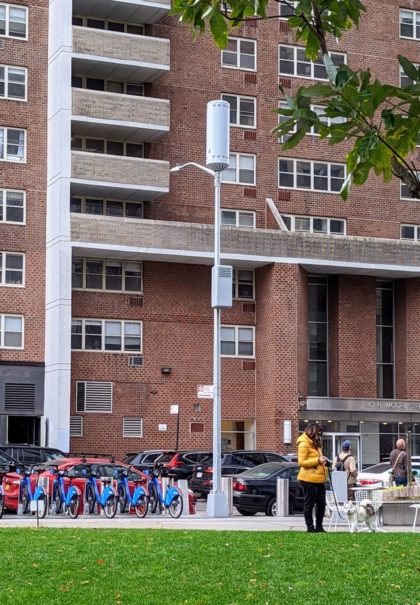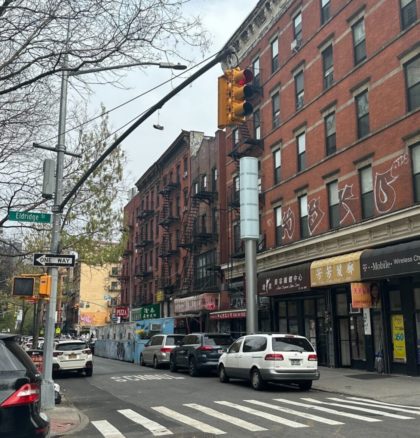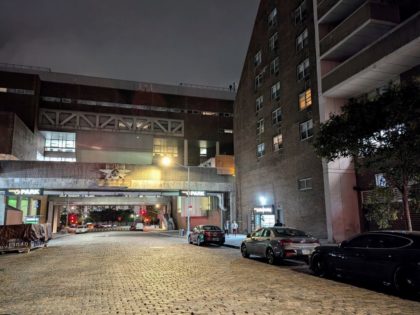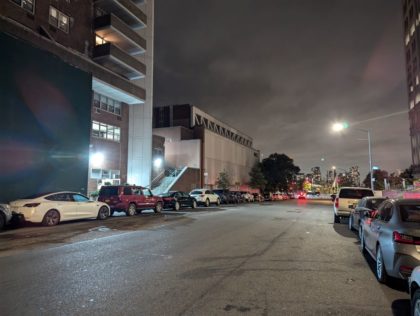More giant cell towers planned for Tribeca and Fidi streets
This all started two years ago, when R. first spotted the installation of a 32-foot cell tower on Greenwich and N. Moore, in his photo above. The city’s Office of Technology and Innovation called it a “5G poletop,” a way to add 5G antennas on poles that previously only housed 4G equipment. (See more on that explanation below and in this post.)
Fast forward to the latest 5G tower plan and I will have to apologize for calling those original ones ugly — because the new versions are way more deserving. The new plan from LinkNYC, the network of free Wi-Fi stations, is to mount 4000 new poles that are 32 feet high like the others, but bulkier and way more imposing on the streetscape.
The city has targeted two sites in Tribeca and five in Fidi, and I assume there are more to come. Community Board 1 took up the issue this week; they have until Sept. 30 to give an official resolution, but the word out of the committee is that they are opposed — and for lots of good reasons (see the illustration below). Here are the spots:
- 66 Harrison Street (west of Greenwich)
- 100 N. Moore Street (west of Greenwich)
- 95 Wall Street (at Water)
- 88 Pine Street (Water & Front)
- 75 South Street (at Maiden Lane)
- 110 William Street (at John)
- 8 Spruce Street (Nassau and William)
The city sees these as the modern version of phone booths — in other words, a necessary piece of communication technology — which, they argue, took up even more real estate on city sidewalks. These take up a lot more sky — even if their footprint is smaller.
CB1’s concerns include the necessity of the towers (something The Times got into as well); the decision-making process for the location of the new towers; their visual impact; implications on privacy and potential health risks associated with the towers; and the use of public space for what will be private use: while the base of the towers are for connecting the public, the top of the towers are reserved for private companies like Verizon (Gothamist gets into that here) to use for their cell service.
The LinkNYC part of the tower is also supposed to serve those without Wi-Fi — bridging the digital divide. Certainly the two Tribeca towers, which have next to no foot traffic, can’t be in that category. They are clearly there as public infrastructure for private companies. From CB1’s Environmental Protection Committee letter, calling for a moratorium on the towers:
“Members of NYC’s Public Design Commission Design expressed dissatisfaction with the design of the proposed labeling the design “aberrant”, “abysmal” and “obscene” and asked for the towers to be redesigned,” the committee wrote. “And despite claims of an urgent need for digital access, many of the proposed sites are located in affluent areas not prioritized for the 5G roll out as required by CityBridge [the city’s contractor for installation].”
The Manhattan Borough president, Mark Levine, suggested in a letter that the city should use existing public infrastructure — like bus stops or exisiting poles — and slow the process down for more community review. The city’s preservation groups have strongly opposed the scale and design of the towers, arguing they are unsuitable for residential and historic districts.
Clearly the demand is there — we all want our service to work all the time — but there’s got to be a better way.
This from the Office of Technology and Innovation in 2022:
What is it?
“As part of the City’s extensive 5G rollout across the five boroughs, we are installing 5G antennas on poletops that previously only housed 4G equipment. Thousands of poletops have been deployed over the last decade-plus to fill coverage gaps and meet the city’s demands for wireless service. This is particularly important because approximately 40 percent of New York City households lack the combination of home and mobile broadband, including 18 percent of residents – more than 1.5 million people – who lack both.”
They go on: “Poletops like the one depicted in your photo will accommodate both 4G and 5G technology. Note that in the photo the 4G antenna is at the top and is a brown-ish color. The 5G antenna is square/rectangular and will have a cover on it.”
And what it will do?
It will provide ultra-fast 5G connectivity to the surrounding area (approx. 750-1,000 feet). Expanding citywide 5G connectivity, through 5G poletops and Link5G kiosks, is an essential component of our ongoing efforts to bridge the digital divide.
Also, how tall is that??
Around 32 feet.




















These things are such a blight. 95% of the impact they have is ruining the streetscape and attracting homeless.
There must be some underhanded contract between the city and LinkNYC because who here even thinks that the current hideous monolithic looking screens are helping to reduce the digital divide? @person, you’re absolutely right. Another hideous structure that ruins the streetscape. Anything associated with LinkNYC is disastrous.
It took A LONG TIME for Verizon ATT and T-Mobile to design cell tower repeaters and extenders that visually blended in with trees and roofs along with other structures that they would be affixed to, because they too were eyesores in the sky.
These’ll be yet another pole-like structure that’s an obstacle in the way that we have to weave around when walking.
There’s a better way to do this. But it’s definitely suspect that LinkNYC has a stake in this. It’s a FACT that no one likes the monoliths they already have riddled this city with. How they could get repeat business from the city raises eyebrows.
I blame Eric Adams.
There are many organizations opposed to the proposed towers including Friends of the Upper East Side, Village Preservation, The Historic Districts Council, and many more.
The negative impact on historic streetscapes represents a visual blight that cannot be unseen. The fact that our city’s own Public Design Commission rejected the design as “abysmal” and “obscene” ought to have stopped the plan at the outset.
Clearly the mayor cares little for his own commission’s view nor that of its citizens.
I think worse than the visual blight is the severe havoc on the nervous system and brain that EMFs cause, especially to kids.
Yes!! Scary
Public space for private use? Interesting. How about all the tables and chairs and sandwich boards on the sidewalks from cafés and restaurants? They not only are not going anywhere the number seemed to have multiplied since the deadline to remove the outdoor sheds was announced. Now the mayor has been indicted, the police commissioner resigned, I fear more lawlessness is going to be the norm in our neck of the woods.
By the way Canal Smoke Shop that was shut down has returned, lively as ever, the encampment surrounding seems more populated too. And the African counterfeit bazaar is also thriving again just relocated to the east side of Broadway and Canal Street.
The city is too occupied to serve the people, how can we organize and take matter into our own hands?
I called community board 1 twice today and haven’t received a call back yet. This has been proven to be poison to growing kids brains and nervous systems. This is not ok. I want to know if it’s being opposed from our community board.
Community Board 1 passed a resolution opposing proceeding with the installation.
Thank you! That is GREAT news! If anyone hears of next steps please post.